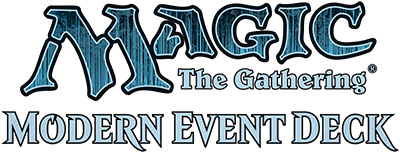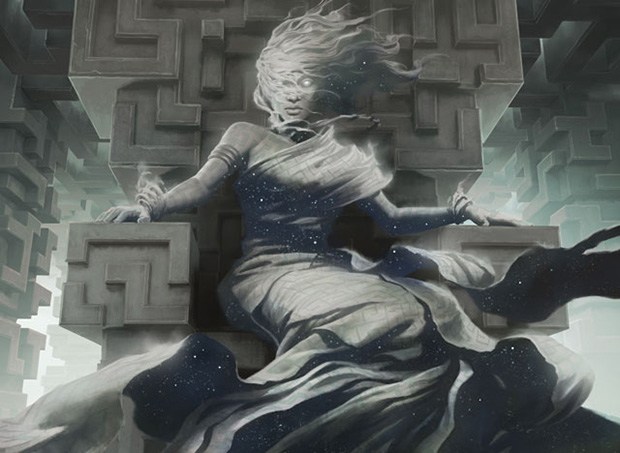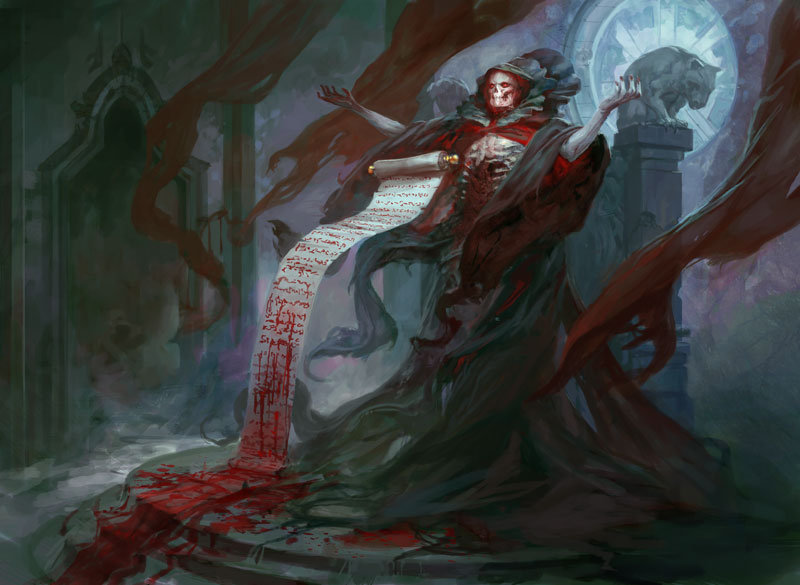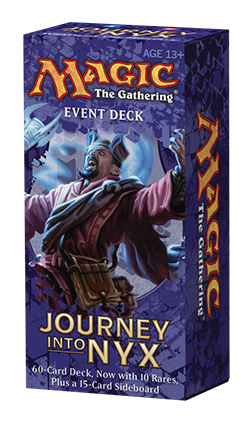By: Jared Yost
Question of Value
From what I’ve been seeing around the internet concerning the Modern event deck, you would think most people would rather go to the dentist than see it printed. I’m going to say this right off the bat – this event deck package is actually pretty decent value.
I know, I must be crazy right? Well, here’s the thing – and I actually didn’t figure this out until I looked it up on the mtgsalvation wiki and confirmed it on Wizard’s website – the thing is that this is not just an event deck. It comes with other things! A spindown life counter, 80 sleeves, and a deck box are also included with this deck. Let’s think about this for a minute.
With all the other event decks you don’t get a package like this. Why? Because those event decks are created for Standard. The people playing Standard already have all of their accessories needed to play that format. New players are entering the market all the time, and they sure aren’t starting with Modern as their format of choice. In a format where $1000+ decks are ruling the Top 8 tables why should they? Standard offers them all they need to get their Magic kick and they are happy just playing that format. The entry point for a decent Standard deck is around $500 if you are going after the singles only and don’t care if they are all in perfectly NM condition and foiled out. Event decks help to fill this gap by providing newer players or even existing players with multiple copies of format staples to make their entrance into Standard that much easier.
What the inclusion of the accessories means is that this event deck was never meant to print $100 bills within a $75 retail package. It was never meant for that Modern player who already has a deck and maybe wanted to branch out into another deck. It was meant for the Modern novice, to understand that Modern exists as a format and that they it doesn’t take much to enter the format if you are willing to play budget versions of decks just like the Standard event decks.
New players to Magic may not even be aware that Modern exists. Wizards really only needs to support Standard. Their support of eternal formats will only work as long as there is a new player already playing Standard and is ready to take the leap to an eternal format. Once they see the event deck and play around with it a bit they will recognize that Modern is a format that is both diverse and rewarding to play. Wizards is just making that connection for the new Standard player by providing them a discount ticket entrance to that format so that they can grab the interest of the few who are willing to make the leap and really jump into the Modern format.
This process has already been started with Modern Masters. Wizards just needed enough time for the set full of reprints to disseminate itself throughout the Magic community in order to drum up more interest in Modern. GP Richmond is a testament to this success story – one of the highest attended constructed events in recent memory, Modern is now on a lot of people’s radars and they are willing to play whatever deck they can get their hands on in order to participate. I know, I was there – plenty of people were playing B/W tokens decks and I even saw one win a GP Trial at the event. Even though it is a “dumb Tier 2 strategy”, many times new arrivals to a format can only afford to play these types of strategies. I know when I first started playing Legacy that the Mono-Red Burn was a very tempting option due to the low barrier to entry. Now that Wizards has solved the problem of the reserved list they can provide event decks for eternal formats, which isn’t something we’ve ever seen before. It is going to take some time for people to understand why Wizards made the choice they did with their first Modern event deck.
From a purely numbers standpoint, I’ve put the entire list including sideboard into the TCGPlayer cart optimizer and this is the approximate value of the deck according to that calcuation (see here for decklist):
Once we add the other parts of the package to the price
– Spindown Life Counter ~$3
– 80 Sleeves ~$6
– Deckbox ~3.50
All told it comes to about $150 of value. Let’s be honest though, the real value of all the pieces of the deck is going to come down once it is released due to an influx of copies entering the market. I’m betting that the actual value will be closer to $100 when everything is said and done.
The cards included might be disappointing for some, but I have a feeling that if Wizards put too many money cards in the deck it would just be sold at absurdly high prices by retailers in order for them to get the most value out of selling the event deck. Wizards didn’t want it to be expensive for Standard players to enter Modern which is why I feel that did not include many of the cards that I predicted they might in a previous article I had written. Honestly, if retailers creating a price barrier is the reason they didn’t include cards like Marsh Flats, Arid Mesa, Fetid Heath, and Auriok Champion in the deck I would wholeheartedly agree with keeping them out even though including them would have lowered their prices by a good margin.
Let’s Do Something About It
There are plenty of ways of improving the deck and not all of them are very costly. Outside of the mana base the rest of the deck can be upgraded rather easily. Just from a quick glance, I would make the following replacements based on this GP Trial Winning List if I were to buy this deck and take to my store’s Modern night.
Maindeck:
– 2 Soul Warden
– 2 Shrine of Loyal Legions
+ 2 Hero of Bladehold
+ 1 Inquisition of Kozilek
+ 1 Path to Exile
Sideboard:
– 2 Ghost Quarter
+ 2 Torpor Orb
Just making these simple replacements makes the deck a lot more consistent and will help your fight against Pod. The manabase may still need some work in order to accommodate the Hero’s but I think that if we’re playing four Spectral Procession main deck anyways it won’t matter in the majority of cases. It may not be the best deck in the room, but when you’re just starting out you need to utilize the tools that are at your disposal.
If you’re playing Standard, you may already have copies of Brimaz, King of Oreskos and Thoughtseize – these are also fine additions to the deck if you can make them fit. The GP Trial deck utilized two Brimaz rather than Tidehollow Scullers (which can be easily removed if your metagame has a lot of U/W/r players) and opted to play four copies of Thoughtseize and only one copy of Inquisition.
The core of the deck is present right out of the box which is good news for the novice Modern player. I’m sure others may argue with my logic but it won’t take much for a Modern beginner to take this deck and start rolling with it. Even if you were to pick up this event deck now, you could start budgeting for the rare lands and even wait for the inevitable reprint of the fetchlands to help supplement this deck. I think it is a good purchase if you’re in the market for a Modern deck because it also allows you get access to things for Commander like Sword of Feast and Famine and Elspeth, Knight-Errant.
I look forward to see what Wizards can do in the future with the Modern event deck products. Like the Commander products that are now yearly I hope that they will make these Modern event decks a yearly, or even biyearly, release in order to get new players that might only be acquainted with Standard interested in the Modern format. Releasing them on a regular basis will also help current Modern players start accumulating a collection so that they can keep building up their Modern card pool over time. I think having this event deck is healthy for the Modern format and for Magic as a whole and I would totally recommend that this deck should be purchased by the target audience for it – Modern rookies.















